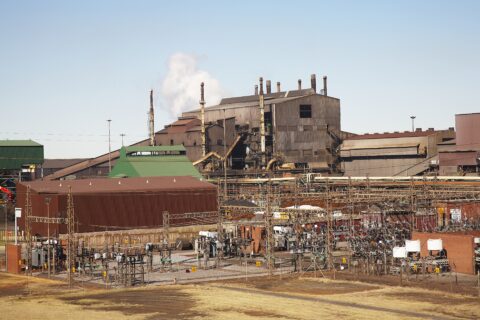SA Mining
Colour Me Beautiful
New kid on the coloured gemstone block Fura Gems is eyeing a secondary listing on the London Stock Exchange, which will give the TSX-listed company access to a larger fundraising platform as it takes its recently acquired emerald and ruby assets up the value chain to production status, CEO Dev Shetty tells SA Mining.
“Fura is exploring the benefits of pursuing a dual listing on the London Stock Exchange (LSE) by the end of 2018, with a potential concurrent fundraise in order to continue the development and production of its emerald and ruby operations. This forms part of a strategy to expand its international profile and capitalise on substantial UK investor interest.”
According to Shetty, the LSE is an attractive option given that it is a mature market which, apart from being easy to tap into, understands the need for marketing and pricing mechanisms.
Established in 2017, Fura is headed up by a team with extensive experience in gemstone mining and former heavyweights from the London-listed Gemfields stable – a leading supplier of coloured gemstones – such as Shetty, Gemfields’ former COO and finance director, Ashim Roy, vice president of operations (former general manager for Gemfields) and Rupak Sen, vice president of marketing and sales at Fura (former Gemfields marketing and sales director for Asia).
The coloured-gemstone producer is focusing on the mining, marketing and selling of rough emeralds from its recently acquired Colombian Coscuez emerald mine, and rubies from Mozambique in Southern Africa. The Coscuez emerald mine is said to have produced over 90% of Colombia’s emerald supply in the 1970s.
“Fura’s strategy is focused on unlocking the potential of known resources and in investing in brownfield operations. Our emerald and ruby assets are both located in legendary gemstone-producing areas. In fact, Colombia is the source of the world’s finest emeralds and accounts for 50% of the value supplied in the market,” explains Shetty.
Emerald mining in Colombia
Fura’s Colombian emerald deposits are located in Boyacá Department along the eastern ranges of the Colombian Andes within two narrow bands on the west side (western zone: Muzo, Cunas and Coscuez deposits) and on the east side (eastern zone: Chivor and Gachalá deposits). Its licence covers an area of 46 hectares and includes exclusive rights for the exploration, construction and mining of emerald deposits.
Fura’s short-term plan will focus on improving the mine’s infrastructure, including the construction of a 1/7 gradient, a ramp system, horizontal tunnel construction to optimise access to the orebody, which will allow for the modernisation of the extractive process and the conversion of the mine into a safer operation. The ramp would optimise the transport of product through LHD trucks, as well as the flow of clean air for ventilation, the company said.
Within the orebody, vertical shafts have also been developed to delineate the extraction blocks for the operation.
In the year ahead, Fura will look at a bulk sampling programme aimed at understanding the orebody. “We are undertaking a 30 000-tonne bulk sampling exercise and a 100m reverse circulation drilling programme with the aim of delivering a long-term mine plan by year end.”
Ruby mining in Mozambique
The Dubai-based company, which holds an 80% stake in four ruby licences (the remaining 20% interest is held by local partners), located in the Montepuez District of Cabo Delgado Province in Mozambique, is looking to start bulk sampling by October.
“Having been intimately involved in the development of Gemfields’ Kagem mine in Zambia and the Montepuez ruby mine in Mozambique, management is already equipped with a good understanding of the geology and orebody,” says Shetty.
He adds that according to the Gemological Institute of America, Mozambique currently accounts for around 50% of the world’s ruby production. “This is therefore an ideal ruby-producing destination to be mining.”
Fura holds five concessions in Mozambique, which span 39 424.51 hectares of highly prospective ground.
The initial findings from the existing artisanal pits show both primary and secondary mineralisation with higher- and lower-quality rubies, Fura’s website states.
Fura plans to start bulk sampling in Mozambique from early October 2018 and plans to bring product to the market through an auction process from the third quarter of 2019.
According to the largest landholder for rubies in the main prospecting area, the aim is to ramp up initial production of one million carats of rubies to four million by 2019 and six million by 2020.
An appetite for sapphires and diamonds?
Shetty, a fan of sapphires, explains that the next step for Fura is “to seek out sapphires”, which are found predominantly in Australia, Thailand, Sri Lanka, China (Shandong), Madagascar, East Africa and North America. Fura, however, is considering Sri Lanka and Madagascar as potential sapphire mining destinations as “they are the biggest known deposits of sapphires today and supply almost 50 to 60% of world sapphires”. “Quality from both Sri Lanka and Madagascar are among the finest found anywhere in the world,” says Shetty.
Apart from rubies and emeralds, Fura is also eyeing Rio Tinto’s former diamond asset in India.
Following Rio Tinto’s decision to streamline its asset portfolio, the diversified miner earlier this year gifted its Bunder diamond project in India to the government of Madhya Pradesh. Although Shetty expects to be one of many companies bidding on the diamond project, he is quick to point out that the Bunder project is the only diamond project that he will consider.
“We will not consider any other diamond project at this point as it fits in well with the Fura strategy, which is to mine in known geographies, minimum life of mine of 15 years and a cash payback period of three years. Rio Tinto has done a significant amount of groundwork on this particular mine. We are quite certain that this mine can produce between two and three million carats of diamonds a year for the next 12 to 15 years. Since the groundwork has already been done, it makes this project interesting for us. That said, this project will be sold by the government of India through an auction process and though we don’t know the outcome, we will surely bid for it. If we get it, it would be good; and if we don’t, we won’t lose sleep over it.”
Market outlook for coloured gemstones
Given the high demand for coloured gemstones, Shetty is confident that Fura will, in the next five years, muscle in on 10% of market share, taking up 15% in the next 10.
“Demand for coloured gemstones is always there. In fact, I believe that there is opportunity for a 20% year-on-year growth in the market over the next 10 years. The challenge is to meet this demand. For instance, Colombia produced 10mcts of emeralds in the year 2000; production subsequently dropped dramatically to 2mcts in 2017, leaving behind a significant gap in the market. However, the entrance of more organised players into the market is expected to see increased gemstone production, which should result in demand being met.”
Interestingly, Fura is looking to ramp up production from its Colombia mine to 10mcts to meet the demand by early next year.
According to Shetty, the gemstone market is a highly lucrative one, with margins surpassing those of the jewellery market. “While the traditional jewellery market
tracks margins of between 2% and 3%, coloured gemstones track margins of between 10 and 15%.”






 Sign-up and receive the Business Media MAGS newsletter OR SA Mining newsletter straight to your inbox.
Sign-up and receive the Business Media MAGS newsletter OR SA Mining newsletter straight to your inbox.